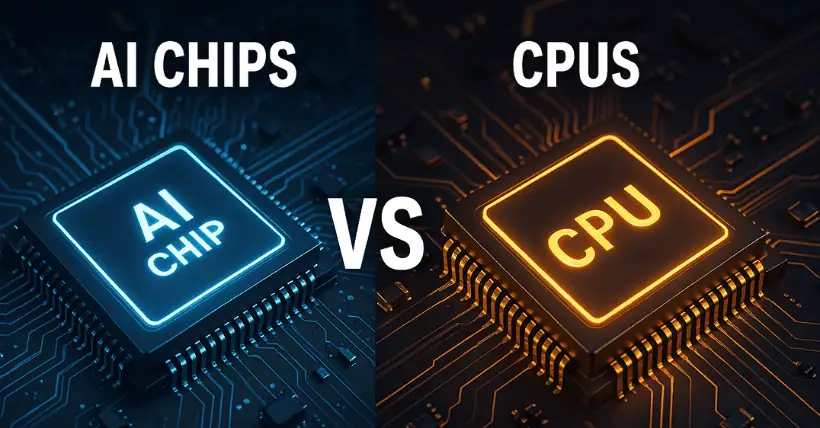Against the backdrop of rapid development in artificial intelligence (AI), traditional general-purpose processors (such as CPUs) can no longer meet the growing computational demands. As a result, AI chips have emerged as the core hardware driving the popularization and advancement of AI applications.
1. Complexity and specificity of AI computation
AI algorithms, especially deep learning, typically require handling vast amounts of data and executing complex matrix computations. While traditional CPU architectures perform well in single-threaded tasks, they are often inefficient when faced with massive parallel computing tasks. In particular, during the training of neural networks, the computational resources of CPUs are often inadequate to meet the needs for fast iteration and high concurrency. AI chips have thus emerged, designed and optimized through specialized hardware to significantly improve the computational efficiency of AI tasks.
Metaphor: A CPU can be compared to a versatile craftsman skilled in many trades, whereas an AI chip is like an artist specialized in carving, focused on deep learning tasks and capable of performing more refined and efficient work in that area.
2. High demands for parallel computatio
AI tasks, especially the training processes in deep learning, involve large-scale parallel computation. Each layer of a deep neural network contains thousands of neurons that must communicate with each other. These computational tasks require hardware capable of large-scale parallel computing and handling multiple tasks simultaneously. Although traditional CPUs with multi-core designs possess some parallel computing capability, they are far inferior compared to AI chips (such as GPUs or ASICs) specifically designed for this purpose.
Analogy: If data processing is seen as a task, a traditional CPU is like a worker completing tasks step by step on an assembly line, whereas an AI chip is like hundreds of workers simultaneously processing on multiple lines in a factory, greatly improving production efficiency.
3. Energy efficiency concerns
When AI tasks run on mobile and edge computing devices, power consumption becomes a critical issue. Traditional processors can execute complex tasks, but due to their architecture not being optimized for AI workloads, they result in low computational efficiency and high power consumption. AI chips, on the other hand, achieve optimization through hardware acceleration and low-power design, significantly reducing power consumption while maintaining high computational performance.
Analogy: A traditional processor can be likened to a fuel-intensive car, whereas an AI chip is like a low-consumption, high-efficiency electric vehicle. AI chips are designed specifically for AI computation, using energy-saving technologies to consume less energy when performing the same tasks.
4. Adaptability and scalability
As AI technology continues to evolve, new applications and algorithms constantly emerge. AI chips are more adaptable and scalable, capable of optimization based on new algorithms and models. Especially with the rise of emerging technologies like quantum computing, photonic computing, and in-memory computing, AI chips can quickly respond and integrate these innovations to maintain their competitive edge.
Analogy: This is like a pair of specially designed sports shoes that can be adjusted and modified to suit different sports as they emerge, meeting more complex and efficient athletic needs.
5. Specialized hardware acceleration
AI chips accelerate different parts of AI computation through dedicated hardware. For instance, hardware modules such as matrix multiplication units, convolution units, and activation function units in AI chips are specifically designed to accelerate AI operations. These hardware acceleration modules can complete large-scale computational tasks in a very short time, greatly reducing the training and inference time of AI.
Analogy: This is like a factory setting up different machines for different tasks, instead of having each worker use the same tool for every job. The specialized hardware modules within AI chips are “dedicated machines” customized for different types of AI tasks.
6. Market demand and application-driven growth
With the wide application of AI technology — from smartphones, autonomous driving, smart homes to medical diagnostics and financial analysis — the demands on AI computing capabilities are growing. To meet these needs, customized AI chips must provide powerful computational support to ensure smooth operation of AI applications.
Analogy: AI chips can be seen as the “engine” of each industry, providing the appropriate power for different application scenarios and driving the rapid development of entire industries.
7. Breakthroughs in the post-Moore’s Law era
Moore’s Law predicts that chip integration doubles every two years, but as transistor sizes approach physical limits, the traditional technological path faces challenges. In this context, AI chips need breakthroughs not only in hardware architecture and computational methods, but also through integration with emerging computing paradigms (such as quantum computing, photonic computing, etc.) to overcome existing technical bottlenecks and continue driving computational growth.
Analogy: This is similar to a traditional car encountering congestion on a highway, while AI chips are like new energy vehicles with new driving mechanisms, capable of breaking through bottlenecks and maintaining rapid progress.
8. Conclusion
The demand for AI chips stems from several aspects: the complexity and parallel nature of AI computation, the urgent need for high efficiency and low power consumption, and the growing market push for AI applications. AI chips provide powerful support for the widespread use of AI through hardware acceleration, low-power design, and adaptable technical architecture, solving the inefficiencies of traditional processors in handling AI tasks. Therefore, AI chips are not only the core driving force behind AI development but also the key to future technological innovation.

Disclaimer: This article is created by the original author. The content of the article represents their personal opinions. Our reposting is only for sharing and discussion purposes and does not imply our endorsement or agreement. If you have any objections, please get in touch with us through the provided channels.



